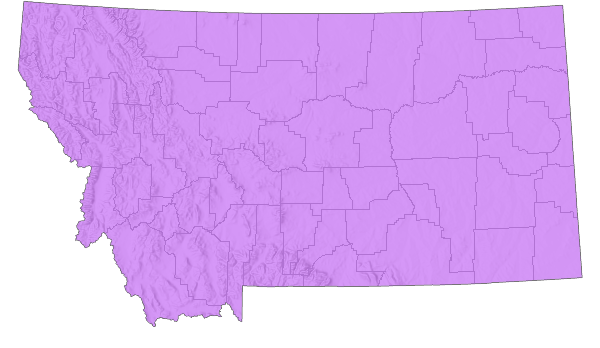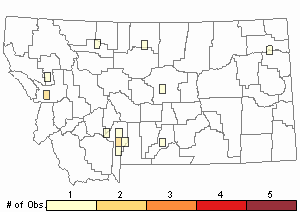View in other NatureServe Network Field Guides
NatureServe
Montana
Utah
Wyoming
Idaho
Wisconsin
British Columbia
South Carolina
Yukon
California
New York
Dawson's Spur-throat Grasshopper - Melanoplus dawsoni
General Description
The following is from Brooks (1958), Vickery and Kevan (1985), Pfadt (2002), Capinera et al. (2004), and Scott (2010). A small, short-winged grasshopper. Some individuals may have long wings which extend 2 to 4 mm beyond the abdomen tip. Body color is dark brown or grayish dorsally and bright yellow ventrally. The abdominal segments are black and ringed with bright yellow. A prominent whitish stripe angles downward on the side of the thorax behind the pronotum.
Phenology
This species overwinters in the egg stage. Eggs generally begin hatching during the first week of June, but depends upon altitude, seasonal temperatures and precipitation. Adults occur from July to October, again subject to climatic and environmental factors (Pfadt 2002, Capinera et al. 2004, Capinera and Sechrist 1982).
Diagnostic Characteristics
The following is taken from Brooks (1958), Vickery and Kevan (1985), Pfadt (2002), Capinera et al. (2004), and Scott (2010). Body size of males is 14 to 19 mm and females is 19 to 25 mm. The outer surface of the hind femur is yellowish with dark chevron-like bands. The hind tibia is red with black spines. Wings are short, about the length of the pronotum, and oval, tapering to a blunt point.
The Dawson's Spur-throat Grasshopper is easily identified from other Melanoplus species due to its small size, short wings, black and yellow ringed abdomen and bright yellow center (Pfadt 2002).
Species Range
Montana Range
Range Descriptions

 Native
Native
Range Comments
Generally a northern grassland species, occurring from the Atlantic coast to the western Great Basin, and southward to northern New Mexico. In Montana, it has been reported in 27 counties (Pfadt 2002, and Scott 2010).
Observations in Montana Natural Heritage Program Database
Number of Observations: 22
(Click on the following maps and charts to see full sized version)
Map Help and Descriptions
Relative Density

Recency



 (Observations spanning multiple months or years are excluded from time charts)
(Observations spanning multiple months or years are excluded from time charts)
Habitat
The Dawson's Spur-throat Grasshopper inhabits grass prairies, shrubby brush and grass-forb park-like wooded areas with a preference for dry soils (Vickery and Kevan 1985, Pfadt 2002, Capinera et al. 2004)
Food Habits
Feeds mainly on forbs. Forty species of forbs in 13 plant families are consumed, including
western ragweed (
Ambrosia psilostachya), lupines,
lead plant (
Amorpha canescens), milkvetches, dandelions, asters, goldenrods, golden pea, legumes,
alfalfa (
Medicago sativa) and
white clover (
Trifolium repens) are also favored. Ten species of grasses (in small amounts) have been found to be consumed (Brooks 1958, Pfadt 2002, and Vickery and Kevan 1985).
Reproductive Characteristics
Upon egg hatching, the nymphs pass through 5 instars and the development period can vary from 20 to 45 days depending upon environmental factors. Transformation to the adult stage continues for four to five weeks in mid to late August. Thus, the adult population consists of varying age classes. Time of attaining sexual maturity has not been studied, but courtship and copulation behaviors have been observed. A courting male produces bursts of vibratory leg stridulation, and when close to a female he makes a sudden jump on her back and continues to stridulate. If she is receptive, copulation begins. The pair can remain attached (in copulo) for a lengthy period, over 2 hours has been observed (Pfadt 2002)!
Stewardship Responsibility
References
- Literature Cited AboveLegend:
 View Online Publication
View Online Publication Brooks, A.R. 1958. Acridoidea of Southern Alberta, Saskatchewan, and Manitoba (Orthoptera). The Canadian Entomologist (Supplement 9) 90:5-92.
Brooks, A.R. 1958. Acridoidea of Southern Alberta, Saskatchewan, and Manitoba (Orthoptera). The Canadian Entomologist (Supplement 9) 90:5-92. Capinera, J.L., R.D. Scott, and T.J. Walker. 2004. Field Guide to Grasshoppers, Katydids, and Crickets of the United States. Ithaca, NY. Cornell University Press.
Capinera, J.L., R.D. Scott, and T.J. Walker. 2004. Field Guide to Grasshoppers, Katydids, and Crickets of the United States. Ithaca, NY. Cornell University Press. Pfadt, R.E. 2002. Field Guide to Common Western Grasshoppers, 3rd edition. Laramie, WY: Wyoming Agricultural Experiment Station, Bulletin 912, modified by S. Schell and S. Schell for electronic publication. Accessed 19 February 2020. http://www.uwyo.edu/entomology/grasshoppers/field-guide/index.html#fieldguidetoc
Pfadt, R.E. 2002. Field Guide to Common Western Grasshoppers, 3rd edition. Laramie, WY: Wyoming Agricultural Experiment Station, Bulletin 912, modified by S. Schell and S. Schell for electronic publication. Accessed 19 February 2020. http://www.uwyo.edu/entomology/grasshoppers/field-guide/index.html#fieldguidetoc Scott, R.D. 2010. Montana Grasshoppers, Katydids, and Crickets A Pictorial Field Guide to the Orthoptera. MagpieMTGraphics, Billings, MT.
Scott, R.D. 2010. Montana Grasshoppers, Katydids, and Crickets A Pictorial Field Guide to the Orthoptera. MagpieMTGraphics, Billings, MT. Vickery, V. R. and D. K. M. Kevan. 1985. The grasshopper, crickets, and related insects of Canada and adjacent regions. Biosystematics Research Institute, Ottawa, Ontario. Publication Number 1777. 918 pp.
Vickery, V. R. and D. K. M. Kevan. 1985. The grasshopper, crickets, and related insects of Canada and adjacent regions. Biosystematics Research Institute, Ottawa, Ontario. Publication Number 1777. 918 pp.
- Additional ReferencesLegend:
 View Online Publication
View Online Publication
Do you know of a citation we're missing? Anderson, N.L. 1951. Field studies on the biology of range grasshoppers of southeastern Montana. M.Sc. Thesis. Bozeman, Montana: Montana State University. 96 p.
Anderson, N.L. 1951. Field studies on the biology of range grasshoppers of southeastern Montana. M.Sc. Thesis. Bozeman, Montana: Montana State University. 96 p. Anderson, N.L. 1962. Grasshopper-vegetation relationships on Montana grasslands. Ph.D Dissertation. Bozeman, Montana: Montana State University. 73 p.
Anderson, N.L. 1962. Grasshopper-vegetation relationships on Montana grasslands. Ph.D Dissertation. Bozeman, Montana: Montana State University. 73 p. Bland, R.G. 2003. The Orthoptera of Michigan—Biology, Keys, and Descriptions of Grasshoppers, Katydids, and Crickets. East Lansing, MI: Michigan State University Extension, Bulletin E-2815. 221 p.
Bland, R.G. 2003. The Orthoptera of Michigan—Biology, Keys, and Descriptions of Grasshoppers, Katydids, and Crickets. East Lansing, MI: Michigan State University Extension, Bulletin E-2815. 221 p. Gillespie, R.L.1992. Dynamics of grasshoppers (Orthoptera: Acrididae) at a rangeland-crop interference. Ph.D. Bozeman, MT: Montana State University. 111 p.
Gillespie, R.L.1992. Dynamics of grasshoppers (Orthoptera: Acrididae) at a rangeland-crop interference. Ph.D. Bozeman, MT: Montana State University. 111 p. Hebard, M. 1928. The Orthoptera of Montana. Proceedings of the Academy of Natural Sciences of Philadelphia, Vol. 80:211-306.
Hebard, M. 1928. The Orthoptera of Montana. Proceedings of the Academy of Natural Sciences of Philadelphia, Vol. 80:211-306. Hebard, M. 1932. Notes on Montana Orthoptera. Proceedings of the Academy of Natural Sciences of Philadelphia. V. 84. pp 251-257.
Hebard, M. 1932. Notes on Montana Orthoptera. Proceedings of the Academy of Natural Sciences of Philadelphia. V. 84. pp 251-257. Henry, J.E. 1969. Protozoan and viral pathogens of grasshoppers. Ph.D. Dissertation. Bozeman, MT: Montana State University. 153 p.
Henry, J.E. 1969. Protozoan and viral pathogens of grasshoppers. Ph.D. Dissertation. Bozeman, MT: Montana State University. 153 p. Kirk, K. and C.R. Bomar. 2005. Guide to the grasshoppers of Wisconsin. Madison, WI: Wisconsin Department of Natural Resources, Bureau of Integrated Science Services PUB-SS-1008. 154 p.
Kirk, K. and C.R. Bomar. 2005. Guide to the grasshoppers of Wisconsin. Madison, WI: Wisconsin Department of Natural Resources, Bureau of Integrated Science Services PUB-SS-1008. 154 p. Skinner, K.F. 1995. Plant and grasshopper community composition: indicators & interactions across three spatial scales. M.Sc. Thesis. Bozeman, MT: Montana State University. 144 p.
Skinner, K.F. 1995. Plant and grasshopper community composition: indicators & interactions across three spatial scales. M.Sc. Thesis. Bozeman, MT: Montana State University. 144 p. Wachter, D.H. 1995. The ecology of selected grasshopper species along an elevational gradient. M.Sc. Thesis. Bozeman, Montana: Montana State University. 59 p.
Wachter, D.H. 1995. The ecology of selected grasshopper species along an elevational gradient. M.Sc. Thesis. Bozeman, Montana: Montana State University. 59 p.
- Web Search Engines for Articles on "Dawson's Spur-throat Grasshopper"
- Additional Sources of Information Related to "Insects"





